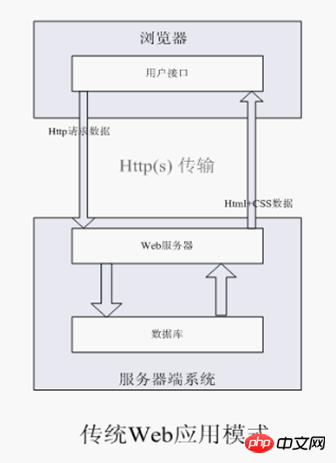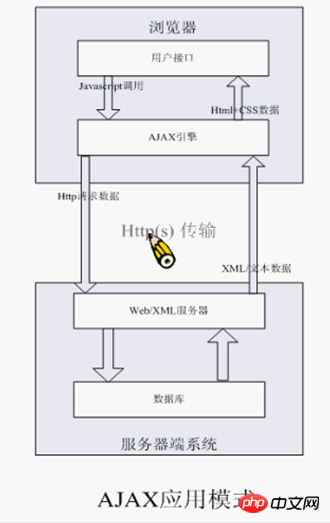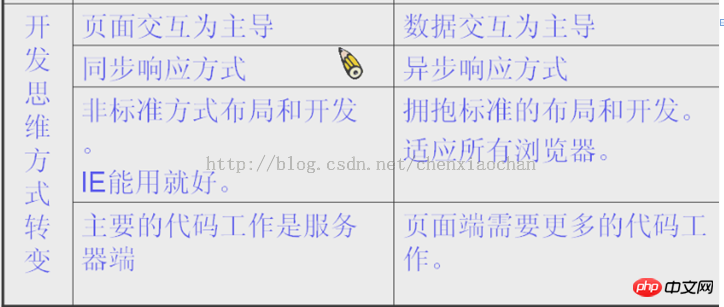 Web Front-end
Web Front-end
 JS Tutorial
JS Tutorial
 Similarities and differences between ajax and traditional web development
Similarities and differences between ajax and traditional web development
Similarities and differences between ajax and traditional web development
This article will introduce to you the similarities and differences between ajax and traditional web development, involving knowledge of ajax and web. Friends who are interested can learn together
AJAX:
What is AJAX
AJAX stands for "Asynchronous Javascript And XML" (Asynchronous JavaScript and XML), which refers to a web development that creates interactive web applications technology.
AJAX = Asynchronous JavaScript and XML (a subset of Standard Universal Markup Language).
AJAX is a technology for creating fast, dynamic web pages. By exchanging a small amount of data with the server in the background
AJAX can make the web page update asynchronously, which means that a certain part of the web page can be updated without reloading the entire web page.
Features of AJAX
Based on Web standards, using the Document Object Model for dynamic display and interaction·Solving page data acquisition, server data analysis, no Refresh the page to update
Use XML and XSLT for data exchange and related operations
Use XMLHTTPRequest for asynchronous data query and reception · Solve the problem of asynchronous interaction
Use JavaScript to bind everything together · Other AJAX technologies Bridge, the most important programming language based on JS. Advanced content for JS. JSON format
Thinking way
User experience
In traditional Web development, if you want to get data from a server-side database or file To obtain information, or send client information to the server, you need to create an HTML form and then GET or POST the data to the server. Users need to click the "Submit" button to send or receive data information, and then wait for the server to respond to the request and the page to reload. Because the server returns a new page every time, traditional web applications can be slow and user-unfriendly. That is: View ->Submit ->Wait ->New page view ->New submission... The page jumps and the whole page refreshes. The user experience will be interrupted

#Using AJAX technology, you can enable Javascript to interact directly with the server through the XMLHttpRequest object. Through HTTP Request, a web page can send a request to the web server and accept the information returned by the web server (without reloading the page). The same page is still displayed to the user. The user feels that the page is refreshed and cannot see the Javascript background processing. to send requests and receive responses.
AJAX process in terms of user experience: View—>Submit—>Continue browsing—>View old page—>New submission... The page does not refresh, and the user experience is consistent.

AJAX uses asynchronous, while the traditional Web uses synchronous. Synchronous updates require the entire page to be updated and displayed as a new page.

Asynchronous update is a small amount of data exchange between the background and the server, that is, a certain part of the webpage can be updated without reloading the entire webpage. And AJAX reduces the user's waiting time.

Development thinking
Traditional Web PK AJAX method
Style

Advantages and Disadvantages
Advantages:
1. Through asynchronous mode, the web page does not refresh, which improves the user experience.
2. Optimize the transmission between the browser and the server, reduce unnecessary data round-trips, and reduce bandwidth usage.
3. The Ajax engine runs on the client and takes on part of the work originally performed by the server, thereby reducing the server load under large user volumes.
4. Based on standardized and widely supported technology, there is no need to download plug-ins or small programs.
Disadvantages:
1. Ajax does not support the browser back button.
2. Security issues AJAX exposes the details of interaction with the server.
3. The support for search engines is relatively weak.
4. Destroyed the exception mechanism of the program.
5. Not easy to debug.
The above is what I compiled for everyone. I hope it will be helpful to everyone in the future.
Related articles:
Use objects to encapsulate the method of repeated ajax calls
Implement ajax cross-domain request to obtain web pages based on iframe Ajax data
Ajax sending and receiving requests
The above is the detailed content of Similarities and differences between ajax and traditional web development. For more information, please follow other related articles on the PHP Chinese website!

Hot AI Tools

Undresser.AI Undress
AI-powered app for creating realistic nude photos

AI Clothes Remover
Online AI tool for removing clothes from photos.

Undress AI Tool
Undress images for free

Clothoff.io
AI clothes remover

Video Face Swap
Swap faces in any video effortlessly with our completely free AI face swap tool!

Hot Article

Hot Tools

Notepad++7.3.1
Easy-to-use and free code editor

SublimeText3 Chinese version
Chinese version, very easy to use

Zend Studio 13.0.1
Powerful PHP integrated development environment

Dreamweaver CS6
Visual web development tools

SublimeText3 Mac version
God-level code editing software (SublimeText3)

Hot Topics
 How to solve the 403 error encountered by jQuery AJAX request
Feb 20, 2024 am 10:07 AM
How to solve the 403 error encountered by jQuery AJAX request
Feb 20, 2024 am 10:07 AM
Title: Methods and code examples to resolve 403 errors in jQuery AJAX requests. The 403 error refers to a request that the server prohibits access to a resource. This error usually occurs because the request lacks permissions or is rejected by the server. When making jQueryAJAX requests, you sometimes encounter this situation. This article will introduce how to solve this problem and provide code examples. Solution: Check permissions: First ensure that the requested URL address is correct and verify that you have sufficient permissions to access the resource.
 How to solve jQuery AJAX request 403 error
Feb 19, 2024 pm 05:55 PM
How to solve jQuery AJAX request 403 error
Feb 19, 2024 pm 05:55 PM
jQuery is a popular JavaScript library used to simplify client-side development. AJAX is a technology that sends asynchronous requests and interacts with the server without reloading the entire web page. However, when using jQuery to make AJAX requests, you sometimes encounter 403 errors. 403 errors are usually server-denied access errors, possibly due to security policy or permission issues. In this article, we will discuss how to resolve jQueryAJAX request encountering 403 error
 PHP and Ajax: Building an autocomplete suggestion engine
Jun 02, 2024 pm 08:39 PM
PHP and Ajax: Building an autocomplete suggestion engine
Jun 02, 2024 pm 08:39 PM
Build an autocomplete suggestion engine using PHP and Ajax: Server-side script: handles Ajax requests and returns suggestions (autocomplete.php). Client script: Send Ajax request and display suggestions (autocomplete.js). Practical case: Include script in HTML page and specify search-input element identifier.
 How to solve the problem of jQuery AJAX error 403?
Feb 23, 2024 pm 04:27 PM
How to solve the problem of jQuery AJAX error 403?
Feb 23, 2024 pm 04:27 PM
How to solve the problem of jQueryAJAX error 403? When developing web applications, jQuery is often used to send asynchronous requests. However, sometimes you may encounter error code 403 when using jQueryAJAX, indicating that access is forbidden by the server. This is usually caused by server-side security settings, but there are ways to work around it. This article will introduce how to solve the problem of jQueryAJAX error 403 and provide specific code examples. 1. to make
 How to enable administrative access from the cockpit web UI
Mar 20, 2024 pm 06:56 PM
How to enable administrative access from the cockpit web UI
Mar 20, 2024 pm 06:56 PM
Cockpit is a web-based graphical interface for Linux servers. It is mainly intended to make managing Linux servers easier for new/expert users. In this article, we will discuss Cockpit access modes and how to switch administrative access to Cockpit from CockpitWebUI. Content Topics: Cockpit Entry Modes Finding the Current Cockpit Access Mode Enable Administrative Access for Cockpit from CockpitWebUI Disabling Administrative Access for Cockpit from CockpitWebUI Conclusion Cockpit Entry Modes The cockpit has two access modes: Restricted Access: This is the default for the cockpit access mode. In this access mode you cannot access the web user from the cockpit
 How to get variables from PHP method using Ajax?
Mar 09, 2024 pm 05:36 PM
How to get variables from PHP method using Ajax?
Mar 09, 2024 pm 05:36 PM
Using Ajax to obtain variables from PHP methods is a common scenario in web development. Through Ajax, the page can be dynamically obtained without refreshing the data. In this article, we will introduce how to use Ajax to get variables from PHP methods, and provide specific code examples. First, we need to write a PHP file to handle the Ajax request and return the required variables. Here is sample code for a simple PHP file getData.php:
 Is PHP front-end or back-end in web development?
Mar 24, 2024 pm 02:18 PM
Is PHP front-end or back-end in web development?
Mar 24, 2024 pm 02:18 PM
PHP belongs to the backend in web development. PHP is a server-side scripting language, mainly used to process server-side logic and generate dynamic web content. Compared with front-end technology, PHP is more used for back-end operations such as interacting with databases, processing user requests, and generating page content. Next, specific code examples will be used to illustrate the application of PHP in back-end development. First, let's look at a simple PHP code example for connecting to a database and querying data:
 PHP vs. Ajax: Solutions for creating dynamically loaded content
Jun 06, 2024 pm 01:12 PM
PHP vs. Ajax: Solutions for creating dynamically loaded content
Jun 06, 2024 pm 01:12 PM
Ajax (Asynchronous JavaScript and XML) allows adding dynamic content without reloading the page. Using PHP and Ajax, you can dynamically load a product list: HTML creates a page with a container element, and the Ajax request adds the data to that element after loading it. JavaScript uses Ajax to send a request to the server through XMLHttpRequest to obtain product data in JSON format from the server. PHP uses MySQL to query product data from the database and encode it into JSON format. JavaScript parses the JSON data and displays it in the page container. Clicking the button triggers an Ajax request to load the product list.





